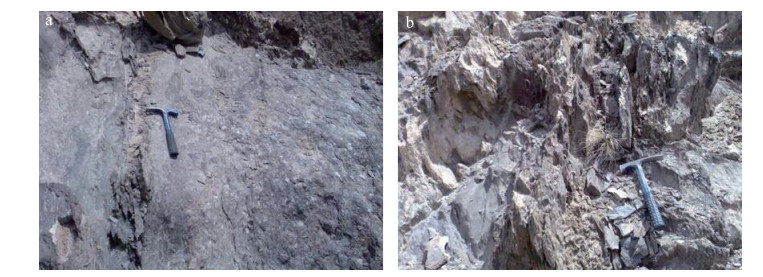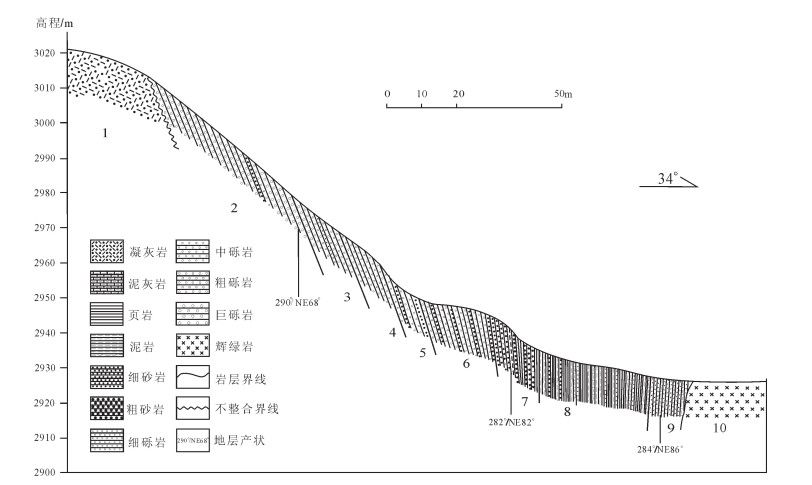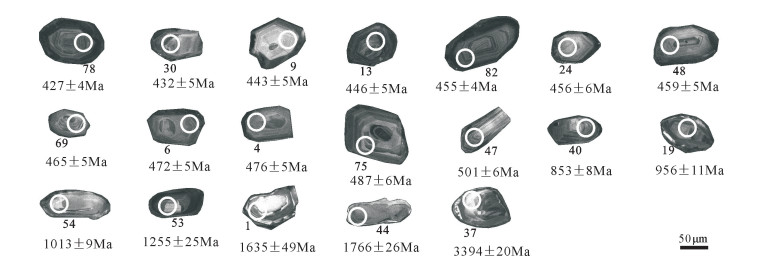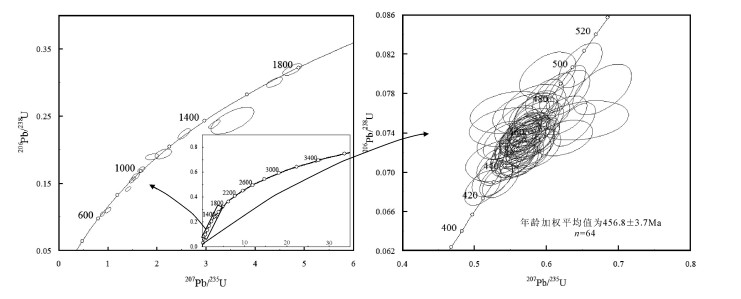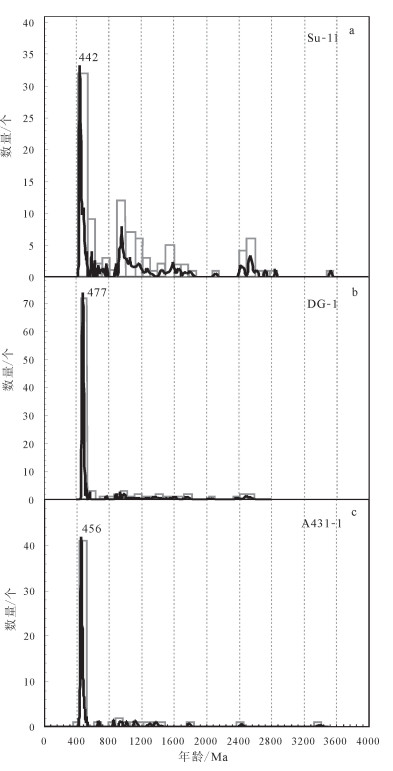Geochronology of the sedimentary series from Zhuo'abulake Formation in Kaladawan area of Altun and its geological significance: LA-ICP-MS U-Pb age evidence of detrital zircons
-
摘要:
以阿尔金喀腊大湾地区卓阿布拉克组沉积岩系砾岩为研究对象,应用LA-ICP-MS方法对碎屑锆石进行U-Pb同位素年龄测定,探讨其形成时代、物源组成和构造背景。研究结果表明:①碎屑锆石年龄谱明显分为2组:522~427Ma和638~1766Ma,另有2个古老的同位素年龄数据分别为2450Ma、3394Ma;②最年轻的碎屑锆石年龄为427±4Ma,说明该砾岩的形成时代晚于427Ma,沉积岩系可能形成于晚志留世—早泥盆世(427~410Ma);卓阿布拉克组存在晚寒武世—早泥盆世的物质组成,应将其解体重新划分;③碎屑锆石峰值年龄为456Ma,表明喀腊大湾地区存在该时期的岩浆活动;522~427Ma的年龄数据约占总体的81%,构成了砾岩中最主要的碎屑锆石群体,说明在早古生代,尤其是晚寒武世—奥陶纪形成的岩浆岩是砾岩最重要的物源,该沉积岩系是敦煌地块向南俯冲、碰撞产生的一系列火成岩在造山剥蚀后的沉积响应;④结合目前北祁连造山带的研究进展和研究区碎屑锆石的研究结果,初步认为喀腊大湾地区卓阿布拉克组沉积岩系和北祁连天祝组、鹿角沟组具有相似的沉积年龄和物质来源,可能同为北祁连-北阿尔金局限洋盆闭合后,陆-陆或弧-陆碰撞造山的产物。
-
关键词:
- 阿尔金 /
- 喀腊大湾地区 /
- 碎屑锆石 /
- LA-ICP-MS锆石U-Pb定年 /
- 物源
Abstract:Choosing the conglomerate from the sedimentary series of Zhuo'abulake Formation in Kaladawan area as the study object and using LA-ICP-MS zircon U-Pb isotope chronology, the authors studied the sedimentary age, material source and tectonic setting of the sedimentary series. Some results were obtained:① The age spectra of detrital zircon can be evidently divided into two groups:522~427Ma and 638~1766Ma, with other two old ages 2450Ma and 3394Ma. ② The youngest age of detrital zircons is 427±4Ma, suggesting that the formation of the conglomerate was later than 427Ma, and hence the formation age of the strata may be constrained from Late Silurian to Early Devonian (427~410Ma); Zhuo'abulake Formation should be divided into more units since it consists of materials from Late Cambrian to Early Devonian. ③ The peak value of the age spectrum is 456Ma, indicating that there existed a magmatic event during this period. The 522~432Ma age data possess the largest proportion and account for about 81% of the total data, showing that the magmatic rocks that were formed in early Paleozoic, especially from late Cambrian to Ordovician constituted the most important source of the conglomerate. The compositional ages suggest a sedimentary response to the orogenic erosion of a series of igneous rocks caused by the southward subduction and collision of Dunhuang massif in early Paleozoic period. ④ Combining the recent research on North Qilian orogenic belt and the study of the detrital zircons in Kaladawan area, the authors consider that sedimentary series of Zhuo'abulake Formation in Kaladawan area and the Tianzhu Formation and Lujiaogou Formation in North Qilian have similar ages and material sources, and they may be the products of continental collision or arc-continent collision after North Qilian-North Altun limited ocean closure.
-
Keywords:
- Altun /
- Kaladawan area /
- detrital zircon /
- LA-ICP-MS zircon U-Pb dating /
- material source
-
致谢: 吉林大学东北亚矿产资源评价国土资源部重点实验室对本次实验的支持与帮助,审稿专家提出宝贵的修改意见,室内工作得到核工业北京地质研究院吴玉博士、地质力学研究所张文高博士的帮助,在此一并表示诚挚的感谢。
-
图 1 阿尔金山东段喀腊大湾地区地质构造图
N1y—中新世下油砂山组;N1g—中新世上干柴沟组;E3g—渐新世下干柴沟组;C3y—上石炭统因格布拉克组;Є3-Os—早古生界斯米尔布拉克组;Є3-Ozh—早古生界卓阿布拉克组;Jx j—金雁山组;Ardg—太古宇达格拉格布拉克组;δ3—早古生代闪长岩;γδ3—早古生代花岗闪长岩;γ3—早古生代花岗岩;ηγ3—早古生代似斑状二长花岗岩;v3—早古生代辉长岩;1—地质界线;2—断裂;3—韧脆性变形带;4—火山-沉积岩系剖面位置;5—图 2、图 4沉积岩系剖面位置;6—采样点;7—样品编号
Figure 1. Map of geological structure in Kaladawan area, eastern part of Altun Mountains
表 1 卓阿布拉克组砾岩(A431-1)碎屑锆石LA-ICP-MS U-Th-Pb分析结果
Table 1 LA-ICP-MS U-Th-Pb isotope composition of zircons from conglomerate in sedimentary series of Zhuo'abulake Formation
点号 含量/10-6 Th/U 同位素比值 年龄/Ma 谐和度 Th U 207Pb/206Pb ±1σ 207Pb/235U ±1σ 206Pb/238U ±1σ 207Pb/206Pb ±1σ 207Pb/235U ±1σ 206Pb/238U ±1σ 1 159 253 0.63 0.1005 0.0029 3.541 0.180 0.2433 0.0081 1635 49 1536 40 1404 42 90% 2 952 1042 0.91 0.0567 0.0013 0.587 0.015 0.0751 0.0009 480 50 469 10 467 5 99% 3 950 1124 0.85 0.0548 0.0014 0.602 0.016 0.0799 0.0010 406 56 478 10 495 6 96% 4 906 1226 0.74 0.0550 0.0014 0.583 0.018 0.0767 0.0009 413 62 467 11 476 6 97% 5 2413 1768 1.36 0.0729 0.0019 1.903 0.057 0.1893 0.0019 1010 55 1082 20 1117 10 96% 6 675 1170 0.58 0.0552 0.0019 0.579 0.022 0.0759 0.0009 420 76 464 14 472 5 98% 7 814 907 0.90 0.0524 0.0020 0.549 0.023 0.0761 0.0009 302 87 445 15 473 5 93% 8 1460 1196 1.22 0.0533 0.0020 0.547 0.022 0.0746 0.0008 343 90 443 15 464 5 95% 9 543 525 1.03 0.0554 0.0021 0.539 0.021 0.0712 0.0009 428 83 437 14 443 5 98% 10 535 1335 0.40 0.0585 0.0016 0.679 0.020 0.0843 0.0009 550 61 526 12 522 5 99% 11 1037 1380 0.75 0.0565 0.0014 0.572 0.016 0.0734 0.0008 472 54 460 10 456 5 99% 12 1484 1990 0.75 0.0565 0.0012 0.567 0.013 0.0728 0.0009 472 42 456 9 453 5 99% 13 2444 2394 1.02 0.0565 0.0010 0.559 0.012 0.0716 0.0008 472 45 451 8 446 5 98% 14 893 1068 0.84 0.0570 0.0012 0.578 0.014 0.0734 0.0009 500 79 463 9 456 5 98% 15 591 705 0.84 0.0575 0.0015 0.582 0.015 0.0735 0.0008 522 57 466 9 457 5 98% 16 500 660 0.76 0.0667 0.0014 1.011 0.023 0.1101 0.0016 828 44 709 12 673 9 94% 17 1004 1087 0.92 0.0574 0.0011 0.581 0.012 0.0733 0.0008 506 44 465 8 456 5 98% 18 2682 2256 1.19 0.0578 0.0009 0.627 0.011 0.0785 0.0010 520 40 494 7 487 6 98% 19 487 683 0.71 0.0708 0.0014 1.565 0.032 0.1599 0.0019 954 34 957 13 956 11 99% 20 912 962 0.95 0.0579 0.0013 0.626 0.014 0.0780 0.0010 524 48 493 9 484 6 98% 21 278 1785 0.16 0.0702 0.0011 1.507 0.025 0.1551 0.0018 933 31 933 10 929 10 99% 22 1002 1252 0.80 0.0578 0.0012 0.580 0.013 0.0725 0.0008 520 48 465 8 451 5 97% 23 1473 1442 1.02 0.0964 0.0013 3.175 0.047 0.2379 0.0027 1567 25 1451 12 1376 14 94% 24 747 1490 0.50 0.0563 0.0010 0.571 0.012 0.0732 0.0009 465 36 459 8 456 6 99% 25 1442 1540 0.94 0.0566 0.0010 0.565 0.010 0.0722 0.0008 476 39 455 7 450 5 98% 26 543 638 0.85 0.0587 0.0014 0.585 0.014 0.0723 0.0008 554 52 468 9 450 5 96% 27 892 1133 0.79 0.0565 0.0011 0.576 0.011 0.0741 0.0008 472 47 462 7 461 5 99% 28 1364 2145 0.64 0.0553 0.0010 0.566 0.011 0.0741 0.0008 433 39 456 7 461 5 98% 29 740 1122 0.66 0.0536 0.0011 0.541 0.012 0.0731 0.0008 354 46 439 8 455 5 96% 30 613 1349 0.45 0.0549 0.0011 0.525 0.012 0.0693 0.0007 409 46 429 8 432 5 99% 31 965 1398 0.69 0.0557 0.0011 0.585 0.012 0.0762 0.0009 439 44 468 8 473 5 98% 32 809 959 0.84 0.0553 0.0010 0.562 0.011 0.0737 0.0008 433 38 453 7 458 5 98% 33 1734 1855 0.93 0.0553 0.0010 0.563 0.011 0.0736 0.0008 433 39 454 7 458 5 99% 34 1272 1470 0.87 0.0554 0.0011 0.557 0.012 0.0729 0.0008 428 44 450 8 453 5 99% 35 526 1376 0.38 0.1595 0.0022 10.10 0.161 0.4582 0.0051 2450 23 2444 15 2432 23 99% 36 2497 1976 1.26 0.0556 0.0009 0.569 0.010 0.0740 0.0008 435 37 457 7 460 5 99% 37 963 845 1.14 0.2857 0.0037 27.47 0.485 0.6932 0.0084 3394 20 3400 17 3395 32 99% 38 1010 1190 0.85 0.0559 0.0012 0.558 0.012 0.0725 0.0007 456 48 450 8 451 4 99% 39 979 1019 0.96 0.0566 0.0011 0.555 0.011 0.0713 0.0007 476 43 448 7 444 4 98% 40 388 1457 0.27 0.0725 0.0010 1.417 0.023 0.1414 0.0014 1011 29 896 10 853 8 95% 41 782 1545 0.51 0.0555 0.0010 0.550 0.011 0.0717 0.0008 432 41 445 7 447 5 99% 42 1027 1033 0.99 0.0577 0.0013 0.578 0.014 0.0726 0.0008 517 44 463 9 452 5 97% 43 98 95 1.03 0.0810 0.0027 2.132 0.070 0.1938 0.0030 1233 66 1159 23 114 16 98% 44 796 997 0.80 0.1080 0.0015 4.760 0.079 0.3192 0.0036 1766 26 1778 14 178 17 99% 45 800 811 0.99 0.0548 0.0013 0.535 0.013 0.0708 0.0008 467 52 435 9 441 5 98% 46 749 1378 0.54 0.0567 0.0011 0.578 0.012 0.0738 0.0008 480 41 463 8 459 5 99% 47 1358 1831 0.74 0.0582 0.0011 0.647 0.012 0.0809 0.0009 600 44 507 8 501 6 98% 48 1568 2276 0.69 0.0551 0.0010 0.561 0.010 0.0737 0.0008 417 39 452 7 459 5 98% 49 652 926 0.70 0.0554 0.0013 0.582 0.014 0.0758 0.0008 428 45 466 9 471 5 98% 50 887 1221 0.73 0.0568 0.0011 0.610 0.012 0.0779 0.0009 483 43 483 8 483 5 99% 51 820 1073 0.76 0.0562 0.0013 0.580 0.014 0.0745 0.0008 461 48 465 9 463 5 99% 52 819 896 0.91 0.0740 0.0029 0.837 0.041 0.0788 0.0010 1043 79 617 23 489 6 76% 53 1198 1520 0.79 0.0824 0.0011 2.558 0.051 0.2235 0.0032 1255 25 1289 15 130 17 99% 54 624 724 0.86 0.0717 0.0012 1.685 0.031 0.1701 0.0017 977 35 1003 12 101 9 99% 55 1971 2710 0.73 0.0592 0.0010 0.624 0.013 0.0758 0.0008 576 35 492 8 471 5 95% 56 969 970 1.00 0.0619 0.0020 0.651 0.026 0.0753 0.0008 672 64 509 16 468 5 91% 57 1040 1496 0.70 0.0561 0.0011 0.576 0.012 0.0744 0.0007 457 43 462 7 462 4 99% 58 1031 1371 0.75 0.0541 0.0011 0.558 0.012 0.0748 0.0008 376 46 451 8 465 5 96% 59 1110 1690 0.66 0.0557 0.0010 0.597 0.011 0.0776 0.0008 443 6 475 7 482 5 98% 60 2143 2191 0.98 0.0550 0.0009 0.548 0.010 0.0720 0.0007 413 37 444 7 448 4 99% 61 915 1141 0.80 0.0556 0.0011 0.583 0.011 0.0762 0.0008 435 44 466 7 473 5 98% 62 1024 877 1.17 0.0576 0.0013 0.566 0.012 0.0714 0.0008 522 48 456 8 445 5 97% 63 1234 1393 0.89 0.0654 0.0014 0.650 0.014 0.0721 0.0007 787 44 509 8 449 4 87% 64 657 1439 0.46 0.0546 0.0010 0.533 0.011 0.0704 0.0007 398 43 434 7 438 4 98% 65 932 1055 0.88 0.0615 0.0015 0.494 0.013 0.0578 0.0006 657 52 408 9 362 4 88% 66 867 861 1.01 0.0562 0.0012 0.554 0.012 0.0713 0.0008 461 48 448 8 444 5 99% 67 287 843 0.34 0.0621 0.0013 0.891 0.020 0.1041 0.0013 676 44 647 11 638 8 98% 68 900 1331 0.68 0.0571 0.0011 0.564 0.012 0.0712 0.0006 498 43 454 8 443 4 97% 69 1186 1476 0.80 0.0620 0.0012 0.639 0.012 0.0748 0.0009 676 43 501 7 465 5 92% 70 777 1011 0.77 0.0579 0.0013 0.575 0.013 0.0719 0.0008 524 48 461 8 448 5 97% 71 2299 2003 1.15 0.0561 0.0010 0.536 0.010 0.0691 0.0007 454 41 436 7 431 4 98% 72 490 1340 0.37 0.0612 0.0015 0.624 0.017 0.0735 0.0007 656 54 492 10 457 4 92% 73 763 4885 0.16 0.0773 0.0013 1.283 0.039 0.1171 0.0023 1128 33 838 17 714 14 84% 74 1564 2180 0.72 0.0559 0.0009 0.567 0.010 0.0734 0.0007 456 37 456 6 457 4 99% 75 1088 1301 0.84 0.0620 0.0012 0.677 0.017 0.0784 0.0010 676 41 525 10 487 6 92% 76 384 709 0.54 0.1059 0.0014 4.398 0.067 0.3001 0.0031 1731 24 1712 13 169 15 98% 77 1847 1759 1.05 0.0578 0.0011 0.590 0.012 0.0738 0.0007 524 43 471 7 459 4 97% 78 1262 1801 0.70 0.0540 0.0010 0.512 0.010 0.0684 0.0007 372 39 420 7 427 4 98% 79 757 784 0.97 0.0534 0.0014 0.539 0.014 0.0732 0.0008 346 59 438 9 456 5 95% 80 1123 1262 0.89 0.0558 0.0011 0.581 0.015 0.0748 0.0011 443 10 465 10 465 7 99% 81 528 924 0.57 0.0567 0.0013 0.562 0.012 0.0721 0.0007 483 50 453 8 449 4 99% 82 1134 2122 0.53 0.0563 0.0009 0.570 0.010 0.0732 0.0007 465 35 458 6 455 4 99% 83 2375 2213 1.07 0.0556 0.0010 0.530 0.009 0.0692 0.0007 435 41 432 6 432 4 99% 84 1009 1360 0.74 0.0551 0.0011 0.554 0.011 0.0729 0.0007 417 44 448 7 454 4 98% -
许志琴, 杨经绥, 张建新, 等.阿尔金断裂两侧构造单元的对比及岩石圈剪切机制[J].地质学报, 1999, 73(3):193-205. http://www.cnki.com.cn/Article/CJFDTOTAL-DZXE199903000.htm Sobel E R, Arnaud N. A possible Middle Paleozoic suture in the Altun Tagh, NW China[J]. Tectonics, 1999, 18(1):64-74. doi: 10.1029/1998TC900023
Yin A, Rumelhart P E, Butler R, et al. Tectonic history of the Altyn Tagh fault system in northern Tibet inferred from Cenozoic sedimentation[J]. Geological Society of America Bulletin, 2002, 114(10):1257-1295. doi: 10.1130/0016-7606(2002)114<1257:THOTAT>2.0.CO;2
毛德宝, 武永平, 葛桂平, 等.阿尔金成矿带主要金属矿床地质地球化学特征及成因初探[J].地质调查与研究, 2006, 29(1):1-9. http://www.docin.com/p-21188523.html Liu Y J, Neubauer F, Genser J, et al. Geochronology of the initiation and displacement of the Altyn Strike-Slip Fault, western China[J]. Journal of Asian Earth Sciences, 2007, 29(2/3):243-252. https://www.researchgate.net/profile/Franz_Neubauer/publication/250967050_40_Ar_39_Ar_age_evidence_for_Altyn_fault_tectonic_activities_in_western_China/links/00b7d51f94383593a6000000.pdf
刘永顺, 辛后田, 周世军, 等.阿尔金山东段拉配泉地区前寒武纪及古生代构造演化[M].北京:地质出版社, 2010:1-211. 陈柏林, 蒋荣宝, 李丽, 等.阿尔金山东段喀腊大湾地区铁矿带的发现及其意义[J].地球学报, 2009, 30(2):143-154. http://www.cqvip.com/QK/98325A/200902/30351098.html 陈柏林, 赵恒乐, 马玉周, 等.阿尔金山阿北银铅矿控矿构造特征与矿床成因初探[J].矿床地质, 2012, 31(1):13-26. http://industry.wanfangdata.com.cn/yj/Detail/Periodical?id=Periodical_kcdz201201002 Gehrels G E, Yin A, Wang X F. Magmatic history of the northeastern Tibetan Plateau[J]. Journal of Geophysical Research, 2003, 108(B9):2423. doi:10. 1029/2002JB002080
韩凤彬, 陈柏林, 崔玲玲, 等.阿尔金山喀腊大湾地区中酸性侵入岩SHRIMP年龄及其意义[J].岩石学报, 2012, 28(7):2277-2291. http://www.wanfangdata.com.cn/details/detail.do?_type=perio&id=ysxb98201207027 陈柏林, 李松彬, 蒋荣宝, 等.阿尔金喀腊大湾地区中酸性火山岩SHRIMP年龄及其构造环境[J].地质学报, 2016, 90(4):708-727. http://www.cnki.com.cn/Article/CJFDTotal-DZXE201604008.htm 陈柏林, 李丽, 祁万修, 等.阿尔金山喀腊大湾铁矿田地质特征与形成时代[J].矿床地质, 2016, 35(2):315-334. http://www.cnki.com.cn/Article/CJFDTotal-KCDZ201602007.htm 高晓峰, 校培喜, 康磊, 等.新疆南部阿尔金东段喀腊大湾铁矿区火山岩成因及地质矿产意义[J].地质通报, 2012, 31(12):2070-2075. doi: 10.3969/j.issn.1671-2552.2012.12.017 崔军文, 唐哲民, 邓晋福, 等.阿尔金断裂系[M].北京:地质出版社, 1999:1-249. 刘良, 车自成, 王焰, 等.阿尔金高压变质岩带的特征及其构造意义[J].岩石学报, 1999, 15(1):57-64. http://industry.wanfangdata.com.cn/jt/Detail/Periodical?id=Periodical_ysxb98199901006 戚学祥, 李海兵, 吴才来, 等.北阿尔金恰什坎萨依花岗闪长岩的SHRIMP U-Pb锆石定年及其地质意义[J].科学通报, 2005, 50(6):571-576. http://edu.wanfangdata.com.cn/Periodical/Detail/kxtb200506012 张建新, 孟繁聪, 于胜尧, 等.北阿尔金HP/LT蓝片岩和榴辉岩的Ar-Ar年代学及其区域构造意义[J].中国地质, 2007, 34(4):558-564. http://www.wanfangdata.com.cn/details/detail.do?_type=perio&id=zgdizhi200704002 杨经绥, 史仁灯, 吴才来, 等.北阿尔金地区米兰红柳沟蛇绿岩的岩石学特征和SHRIMP定年[J].岩石学报, 2008, 24(7):1567-1584. http://www.ysxb.ac.cn/ysxb/ch/reader/create_pdf.aspx?file_no=20080713&journal_id=ysxb&year_id=2008 陈正乐, 万景林, 王小凤, 等.阿尔金断裂8Ma左右的快速走滑及其地质意义[J].地球学报, 2002, 23(4):295-300. http://www.cnki.com.cn/Article/CJFDTOTAL-DQXB200204001.htm 陈柏林, 崔玲玲, 白彦飞, 等.阿尔金断裂走滑位移的新认识——来自阿尔金山东段地质找矿进展的启示[J].岩石学报, 2010, 26(11):3387-3396. http://www.cnki.com.cn/Article/CJFDTOTAL-DQXB200101004.htm 新疆维吾尔自治区地质矿产局.新疆维吾尔自治区地质志[M].北京:地质出版社, 1993:1-941. Ludwig K R. User's manual for Isoplot 3. 00. A geochronological Toolkit for Microsoft Excel[M]. Berkeley Geochronology Center. Special Publication, 2003.
Hoskin P W O. Rare earth element chemistry of zircon and its use as a provenance indicator[J]. Geology, 2002, 28(8):627-630. https://www.researchgate.net/publication/259235572_Rare_earth_chemistry_of_zircon_and_its_use_as_a_provenance_indicator
Belousova E A, Griffin W L, O'Rilly S Y. Igneous zircon:trace element composition as an indicator of source rock type[J]. Contrib. Mineral. Petrol., 2002, 143:602-622. doi: 10.1007/s00410-002-0364-7
Vavra G, Schmid R, Gebauer D. Internal morphology, habit and U-Th-Pb microanalysis of amphibole to granulite facies zircon:geochronology of the Ivren zone (Southern Alps)[J]. Contrib. Mineral. Petrol., 1999, 134(4):380-404. doi: 10.1007/s004100050492
Whitehouse M J, Kamber B S. On the overabundance of light rare earth elements in terrestrial zircons and its implication for Earth's earliest magmatic differentiation[J]. Earth Planet. Sci. Lett., 2002, 204(3/4):333-346. doi: 10.1016/S0012-821X(02)01000-2
徐亚军. 北祁连造山带晚加里东-早海西期造山过程的沉积响应[D]. 中国地质大学(武汉)博士学位论文, 2010. http://cdmd.cnki.com.cn/Article/CDMD-10491-2010250464.htm 王小凤, 陈宣华, 陈正乐, 等.阿尔金地区成矿条件与预测[M].北京:地质出版社, 2004:1-541. 孟令通, 陈柏林, 王永, 等.北阿尔金早古生代构造体制转换的时限:来自花岗岩的证据[J].大地构造与成矿学, 2016, 40(2):295-307. http://www.wanfangdata.com.cn/details/detail.do?_type=perio&id=ddgzyckx201602010 康磊, 刘良, 曹玉亭, 等.北阿尔金构造带红柳沟钾长花岗岩地球化学特征、LA-ICP-MS锆石U-Pb定年和Hf同位素组成[J].地质通报, 2011, 30(7):1066-1076. http://dzhtb.cgs.cn/ch/reader/view_abstract.aspx?file_no=20110709&flag=1 修群业, 于海峰, 刘永顺, 等.阿尔金北缘枕状玄武岩的地质特征及其锆石U-Pb年龄[J].地质学报, 2007, 81(6):787-794. http://www.oalib.com/paper/4874121 刘良. 阿尔金高压变质岩与蛇绿岩及其大地构造意义[D]. 中国科学院地质与地球物理研究所博士学位论文, 1999: 29-36. http://www.wanfangdata.com.cn/details/detail.do?_type=degree&id=Y323646 陈宣华, Gehrels G E, 王小凤, 等.阿尔金山北缘花岗岩的形成时代及其构造环境探讨[J].矿物岩石地球化学通报, 2003, 22(4):294-298. http://www.wanfangdata.com.cn/details/detail.do?_type=perio&id=kwysdqhxtb200304002 吴才来, 杨经绥, 姚尚志, 等.北阿尔金巴什考供盆地南缘花岗杂岩特征及锆石SHRIMP定年[J].岩石学报, 2005, 21(3):846-858. http://www.wanfangdata.com.cn/details/detail.do?_type=perio&id=ysxb98200503024 吴才来, 姚尚志, 曾令森, 等.北阿尔金巴什考供-斯米尔布拉克花岗杂岩特征及锆石SHRIMP U-Pb定年[J].中国科学(D辑), 2007, 37(1):10-26. http://www.wanfangdata.com.cn/details/detail.do?_type=perio&id=zgkx-cd200701002 吴玉, 陈正乐, 陈柏林, 等.阿尔金北缘脆-韧性剪切带内变形闪长岩的年代学、地球化学特征及其对北阿尔金早古生代构造演化的指示[J].岩石学报, 2016, 32(2):555-570. http://www.ysxb.ac.cn/ysxb/ch/reader/create_pdf.aspx?file_no=20160219&year_id=2016&quarter_id=2&falg=1 孟令通, 陈柏林, 罗迪柯, 等.北阿尔金喀腊大湾地区4337高地北花岗闪长岩SHRIMP U-Pb定年及其构造意义[J].吉林大学学报(地球科学版), 2015, 45(6):1757-1771. http://www.wanfangdata.com.cn/details/detail.do?_type=perio&id=cckjdxxb201506017 吴才来, 姚尚志, 杨经绥, 等.北祁连洋早古生代双向俯冲的花岗岩证据[J].中国地质, 2006, 33(6):1197-1208. http://www.cqvip.com/QK/90050X/200606/23559664.html 曾建元, 杨怀仁, 杨宏仪, 等.北祁连东草河蛇绿岩:一个早古生代的洋壳残片[J].科学通报, 2007, 52(7):825-835. http://www.cnki.com.cn/Article/CJFDTOTAL-KXTB200707019.htm 陈其龙. 北祁连牛心山岩体岩石学、锆石SHRIMP定年及其成因[D]. 首都师范大学硕士学位论文. 2009 http://cdmd.cnki.com.cn/Article/CDMD-10028-2009130534.htm 吴才来, 徐学义, 高前明, 等.北祁连早古生代花岗质岩浆作用及构造演化[J].岩石学报, 2010, 26(4):1027-1044. http://www.ysxb.ac.cn/ysxb/ch/reader/view_abstract.aspx?file_no=20100403 李兆, 陈岳龙, 刘长征, 等.北祁连的形成与演化历史:来自河流沉积物地球化学及其碎屑锆石U-Pb年龄、Hf同位素组成的证据[J].地质学报, 2016, 90(2):267-282. http://www.oalib.com/paper/4875049 Li Z X, Bogdanova S V, Collins A S, et al. Assembly, configuration and break-up history of Rodinia:A synthesis[J]. Precambrian Research, 2008, 160(1/2):179-210. https://www.deepdyve.com/lp/elsevier/assembly-configuration-and-break-up-history-of-rodinia-a-synthesis-9cLQBUNkck
Meert J G, Torsvik T H. The making and unmaking ofsupercontinent:Rodinia revisited[J]. Tectonophysics, 2003, 375(1/4):261-228. https://www.researchgate.net/publication/222672332_The_making_and_unmaking_of_a_supercontinent_Rodinia_revisited
陆松年, 于海峰, 李怀坤, 等.中国前寒武纪重大地质问题研究——中国西部前寒武纪重点地质事件群及全球构造意义[M].北京:地质出版社, 2006:1-197. 王超, 刘良, 车自成, 等.阿尔金南缘榴辉岩带中花岗片麻岩的时代及构造环境探讨[J].高校地质学报, 2006, 12:74-82. doi: 10.3969/j.issn.1006-7493.2006.01.008 覃小锋, 夏斌, 黎春泉, 等.阿尔金构造带西段前寒武纪花岗质片麻岩的地球化学特征及其构造背景[J].现代地质, 2008, 22(1):34-44. http://www.cqvip.com/QK/96868X/200801/26493920.html 张志诚, 郭召杰, 冯志硕, 等.阿尔金索尔库里地区元古代流纹岩锆石定年及其地质意义[J].岩石学报, 2010, 26(2):597-606. http://www.ysxb.ac.cn/ysxb/ch/reader/view_abstract.aspx?file_no=20100220 王立社, 张巍, 段星星, 等.阿尔金环形山花岗片麻岩同位素年龄及成因研究[J].岩石学报, 2015, 31(1):119-132. http://www.ysxb.ac.cn/ysxb/ch/reader/create_pdf.aspx?file_no=20150109&journal_id=ysxb&year_id=2015 张建新, 李怀坤, 孟繁聪, 等.塔里木盆地东南缘(阿尔金山)"变质基底"记录的多期构造热事件:锆石U-Pb年代学的制约[J].岩石学报, 2011, 27(1):23-46. http://mall.cnki.net/magazine/Article/YSXB201101003.htm 梅华林, 于海峰, 李铨, 等.甘肃北山地区首次发现榴辉岩和古元古花岗质岩石[J].科学通报, 1998, 43(19):2105-2111. doi: 10.3321/j.issn:0023-074X.1998.19.022 郭进京, 赵凤清, 李怀坤, 等.中祁连东段晋宁期碰撞型花岗岩[J].地球学报, 1999, 20(1):10-15. http://www.cnki.com.cn/Article/CJFDTOTAL-DQXB901.001.htm Wan Y S, Zhang J X, Yang J S, et al. Geochemistry of high-grade metamorphic rocks of the North Qaidam Mountains and their geological significance[J]. Journal of Asian Earth Sciences, 2006, 28:174-184. doi: 10.1016/j.jseaes.2005.09.018
董国安, 杨怀仁, 杨宏仪, 等.祁连地块前寒武纪基底锆石SHRIMPU-Pb年代学及其地质意义[J].科学通报, 2007, 52(13):1572-1585. doi: 10.3321/j.issn:0023-074X.2007.13.015 郭召杰, 张志诚, 王建君.阿尔金山北缘蛇绿岩带的Sm-Nd等时线年龄及其大地构造意义[J].科学通报, 1998, 43(18):1981-1984. doi: 10.3321/j.issn:0023-074X.1998.18.018 刘函, 王国灿.北阿尔金拉配泉米兰群片麻岩及其中两期基性岩墙群LA-ICP-MS锆石U-Pb年龄及地质意义[J].地质通报, 2012, 31(9):1461-1468. http://dzhtb.cgs.cn/ch/reader/view_abstract.aspx?file_no=20120910&flag=1 曾建元, 杨宏仪, 万渝生, 等.北祁连山变质杂岩中新元古代(~775Ma)岩浆活动纪录的发现:来自SHRIMP锆石U-Pb定年的证据[J].科学通报, 2006, 51(5):575-581. http://www.cnki.com.cn/Article/CJFDTOTAL-KXTB200605011.htm 于福生, 漆家福, 王春英, 等, 北祁连东段新元古代火山岩的发现及其特征和形成环境[J].大地构造与成矿学, 2001, 25(1):74-82. http://www.cnki.com.cn/Article/CJFDTOTAL-DGYK200101007.htm Lu S N, Li H K, Zhang C L, et al. Geological and geochronological evidence for the Precambrian evolution of the Tarim Craton and surrounding continental fragments[J]. Precambriam Research, 2008, 160:94-107. doi: 10.1016/j.precamres.2007.04.025
李惠民, 陆松年, 郑建康等.阿尔金东段花岗片麻岩中3.6Ga锆石的地质意义[J].岩石矿物地球化学通讯, 2001, 20:259-262. http://www.cnki.com.cn/Article/CJFDTotal-YSXB200908007.htm Xu Y J, Du Y S, Peter A C, et al. Detrital zircon record of continental collision:Assembly of the Qilian Orogen, China[J]. Sedimentary Geology, 2010, 230:35-45. doi: 10.1016/j.sedgeo.2010.06.020
Yang J H, Du Y S, Peter A C, et al. Silurian collisional suturing onto the southern margin of the North China craton:Detrital zircon geochronology constraints from the Qilian Orogen[J]. Sedimentary Geology, 2009, 220:95-104. doi: 10.1016/j.sedgeo.2009.07.001
郝杰, 王二七, 刘小汉, 等.阿尔金山脉中金雁山早古生代碰撞造山带:弧岩浆岩的确定与岩体锆石U-Pb和蛇绿混杂岩40Ar/39Ar年代学研究的证据[J].岩石学报, 2006, 22(11):2743-2752. http://www.oalib.com/paper/4874341 新疆维吾尔自治区地质矿产局. 1: 20万索尔库里幅和巴什考供幅区域地质调查报告. 1981. 陈柏林. 阿尔金成矿带多元信息成矿预测与找矿示范专题报告. 2016.



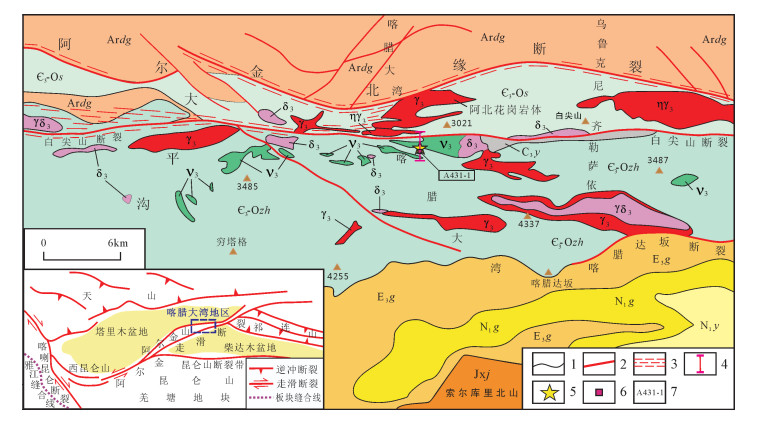
 下载:
下载:

